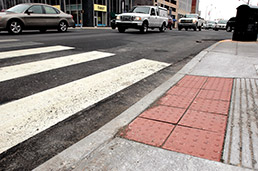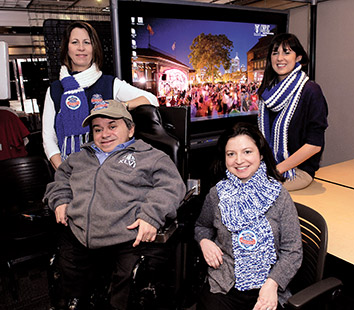Subscriber Benefit
As a subscriber you can listen to articles at work, in the car, or while you work out. Subscribe NowAttorney Greg Fehribach is looking forward to Super Bowl XLVI, when thousands of visitors to Indianapolis will make their way through downtown, thanks in part to infrastructure he helped design. For Fehribach, who uses a wheelchair as a mobility aid, the hallmark of any great city is its ability to offer everyone the same experiences.
A different world
When Fehribach was a child growing up in the Circle City – before the Americans with Disabilities Act of 1990 – getting from point A to point B required a bit more planning.

“There was no accessibility – actually you didn’t even have to be accessible in the United States until 1990. In the ’70s, education required more accessible features, but cities and towns didn’t have to have curb cuts or anything to that effect,” he said.
Reflecting on his decision to become a lawyer, Fehribach smiled and said that because his mother emphati-
cally told him he could not become a ditch digger, he had to come up with a different plan. And he said law seemed like a good career for a person with a disability.
“Plus, law is still one of the only professions in the world where you can actually change the world with a pen and paper, and that had an awful lot of interest to me,” he said.
So Fehribach became a lawyer, sworn in to practice four years before “ADA compliance” had become part of the American vocabulary. He continues to serve as of counsel for Doninger Tuohy & Bailey, and he leads his own consulting firm, The Fehribach Group. In that role, he has helped engineers, project managers and architects shape the kind of all-inclusive environments that didn’t exist when he was a child – among them, Lucas Oil Stadium.
Before Lucas Oil Stadium was built, the Indianapolis Colts played at the RCA Dome. Built before the days of ADA, the RCA Dome’s accessible seating was cordoned off from other seating, and visitors had to enter through a separate door to reach it. Lucas Oil Stadium was designed so that all of its entryways are wheelchair-friendly, and its accessible seating is found throughout the venue, allowing people who use mobility aids to be part of the crowd.
It’s not just the buildings and sidewalks that have changed over time; societal attitudes have changed, too.
Fehribach said in the past, the question on most business owners’ minds was: What do we have to do to be ADA-compliant? But now, savvy business owners ask, “How can we do more?” Because they understand that people with disabilities have money to spend.
The economics of inclusion
Sitting at a table with his wife and business manager Mary Beth Fehribach; his administrative and communications coordinator Jennifer Mendoza; and Juli Paini, attorney and director of the Office of Disability Affairs for the City of Indianapolis; Greg Fehribach explained that years ago, the public perception of people with disabilities was that they needed help.
“Typically, from a social service perspective, you look at a health care model or a health care philosophy with people with disabilities – they were sick, and so how do you care for sick people?” he said. “Now, it’s more of an economic model, meaning people with disabilities – Juli and I are two of them – we’d like to buy a cup of coffee, or we’d like to buy a ticket to a ballgame or to a show or an event. It’s not so much: Do we have to let them in? It’s: Of course we want them in; we want to get into their pockets!”
Fehribach said lawyers can help shift the focus for their business clients away from being so worried about costs that they fail to see the benefits people with disabilities can offer as members of the workforce and as consumers.
A study by disability advocacy group Open Doors Organization estimated in 2003 that people with disabilities would spend $35 billion dining at restaurants that year. And the study found that more than 75 percent of people with disabilities eat at restaurants at least once a week.
Defining good design
On an icy, blustery day, Paini wraps her hands around her Starbucks cup as she ponders what factors constitute an accessible environment.
“You know that you’ve created a universally accessible space or program when people don’t notice,” she said. “For me, with my particular disability, to walk down a street that’s accessible, my disability really doesn’t come into play. It’s when you have those barriers and you have to address them that disability comes into play, and so a universally accessible environment – which we’ve created here in Indianapolis – everyone’s going to be able to enjoy.”
Paini, the Fehribachs and Mendoza are all members of the ADA Disability Inclusion Subcommittee of the 2012 Indianapolis Super Bowl Host Committee. Other members include Larry Markle, director of disabled student development for Ball State University; Carlos Taylor, director of adaptive technology for Ball State University; and Peter Bisbecos, an attorney who was the first official to oversee ADA compliance in Indianapolis in a role that later developed into the one Paini fulfills now.
In 1992, Bisbecos’ first task was ensuring city buses were accessible. Of the many gains Indianapolis has made over the years in allowing all people to share in the same experiences, Bisbecos seems most impressed with the design of Bankers Life Fieldhouse, home court for the Indiana Pacers and Indiana Fever.
“If you look at the fieldhouse, if you look at the decks between the levels, that’s the best accessible seating in the country,” he said. “Because there is no fixed seating there, a person can interact more with a person who comes with them. Accessible seating used to be so limited that only a few people could go.”
Bisbecos said that another benefit the mezzanine-level seating offers is that when fans closer to the court leap to their feet in excitement, they aren’t blocking the view of people sitting in the middle level.
“That was Greg’s idea,” Bisbecos said. “He may say it was somebody else’s idea, but I think it was his.”
Bisbecos said he’s excited that so many people around the world will turn their focus to Indianapolis for the Super Bowl.
“Indianapolis has got a lot to be proud of,” he said.
Learning opportunities
In his blog, Greg Fehribach wrote about a recent experience where he was part of a group that was receiving an honor, and when honorees were called to the stage – due to the tight clearance between tables – he wasn’t able to join his colleagues. Even if he had been able to maneuver through the narrow aisles, he could not have accessed the elevated stage.
While some people may interpret that event as unfortunate and disappointing, Fehribach sees it as a way to bring people closer together.
“Education is a fascinating trade, and often times when you’re a learner, you can read a textbook, but the learner doesn’t always grasp it until they actually see the issue being negative or positive in motion, so there’s suddenly an ‘a-ha’ moment when a learner and educator have that opportunity to share mutual experiences,” he said. “I think the Super Bowl is that mutual experience for Indianapolis at this time. Sport has always been that bridging of social, economic and other factors because we all cheer for the same things or for the same team – or half cheer for one, and half cheer for the other – and that cheering for a common cause is what breaks down barriers.”
More work to be done
Fehribach takes pride in the many projects the city has completed in order to be more accommodating of its residents. And in 2009, the National Organization on Disability named Indianapolis the most disability-friendly city in the United States. But Fehribach is quick to point out that the progress he’s seen so far is just the beginning.
“It’s fun to watch the project and the space mature because then that allows more people to use the space, the facility or the program more inclusively every single day,” he said. “So when you open up a project, when you begin a project, you don’t go for the expectation of this is the end. It’s only the beginning.”•
Please enable JavaScript to view this content.

